Alfalfa Weevil
Hypera postica Gyllenhal
The alfalfa weevil is one of the primary insect defoliators of alfalfa. Thought to be of Asian origin, the alfalfa weevil was introduced into the United States from southern Europe. First discovered in 1904 in Utah, it is now present in all 48 mainland states. Annually, insect pests of alfalfa, including the alfalfa weevil and potato leafhopper, cause hundreds of millions of dollars in losses. Though difficult to estimate, these same insects are estimated to reduce yields by 10 to 15% annually (forage quality not taken into account). Introduced biologicalcontrol agents and natural enemies have reduced alfalfa weevil populations in many areas, though it continues to be a sporadic pest of alfalfa.
Description
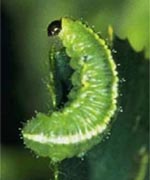
Alfalfa weevil larva
Alfalfa weevil adults are small (1/4 inch) brown snout beetles that have a distinctive dark, narrow stripe which extends down their back. Adult weevils insert yellow oval eggs into alfalfa stems. Following egg hatch, small legless yellowish-green larvae, each with a white stripe along
the middle of the back, emerge. A fainter white stripe is also present on each side of the more prominent central stripe. Eachlarva has a very conspicuous black head and is approximately 3/8 inch when mature. Transformation to the adult stage is passed in a looselywoven white cocoon, about the size of a pea, to which leaves may be attached.
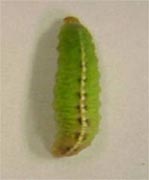
Clover leaf weevil larva
(M. Montgomery, UI Extension)
The alfalfa weevil can be confused with the clover leaf weevil which is another pest of alfalfa. However, clover leaf weevils rarely cause economic injury in alfalfa in Illinois. Larvae of both these species are similar, but have distinct differences in appearance. The clover leaf weevil is green with a white stripe down the center of its back,but the white stripe is bordered with smudges of pink or red; the head of the clover leaf weevil is tan. Adult clover leaf weevils are about two times larger than the alfalfa weevil (5/16 inch long), light brown, with a wide dark brown stripe on the back.
Life Cycle
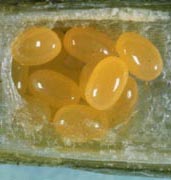
Alfalfa weevil eggs
(Purdue University)
Some initial egg laying during November may take place before the onset of cold weather. During the winter, when temperatures permit, adults may deposit some eggs. Generally weevils become active in late March or early April in Illinois. Female weevils insert eggs in clusters of 2 to 25 inside alfalfa stems. Larvae become noticeable in April and readily observable in early June. The green larvae feed for roughly 3 to 4 weeks depending on the quality of the alfalfa and the temperature. Larvae molt or shed their skins three times. Following the last larval instar, cocoons are spun on plants or in curled up leaves that have fallen to the ground. The pupal stage requires 1 to 2 weeks for completion. Upon their emergence from cocoons, adults feed for a week or two, and then move to sheltered areas to spend an inactive summer. It is quite likely that at any given point in time during the summer, most, if not all, alfalfa weevil life stages can be found. Older adult weevils may continue their egg-laying activities, while at the same time, larvae, cocoons, and newly emerged adults may also be observed. Upon the arrival of colder weather, adult weevils seek out the crowns of alfalfa plants, or the protection of wooded areas or vegetation provided in ditch banks or fence rows to overwinter.
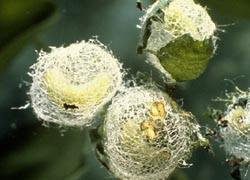
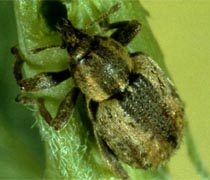
Alfalfa weevil cocoon Alfalfa weevil adult
Injury

Alfalfa weevil injury - leaf skeletonization
Both adults and larvae feed on alfalfa foliage, but the larvae cause the majority of the damage. Larvae feed initially on the inside of terminal leaves and later move to foliage on the lower portion of the plant. Early season larval damage (first and second instars) shows up as pinholes in leaf terminals. Leaves are skeletonized as larvae increase in size. Third and fourth instars defoliate plants by feeding between the veins, and also on the buds and growing tips. Adults generally feed on the leaf margins which creates a feathery appearance of the foliage. Injured leaves dry very quickly giving the field a grayish to whitish cast.
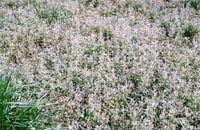
Severe alfalfa weevil injury - "frosting"
Alfalfa weevils have the ability to severely damage the first cutting of hay in much of Illinois. In southern areas, significant egg laying may take place during the fall, predisposing some alfalfa fields to early larval damage the following spring. In contrast, alfalfa weevil damage to hay in northern Illinois is likely only if the first harvest has been delayed. Injury to alfalfa in the northern portion of the state will most probably occur on the stubble and tender growth of the second crop.
Clover leaf weevils and alfalfa weevils also feed and behave differently. Alfalfa weevils feed during the day, actively feeding on the foliage, starting near the leaf tips. Clover leaf weevils feed at night, usually on the lower leaves. They can be found on the ground, near the crowns during the day.
Scouting Procedure

Alfalfa weevil head capsule gauge
Alfalfa producers in southern and central Illinois should monitor stands very carefully in March, April, May, and June. Alfalfa stands in northern Illinois should be scouted for larval damage in May and June. Growers should always examine stubble following the first harvest, because of the potential for larval and adult feeding on new tender growth.
Fields should be scouted in a U-shaped pattern. Care should be taken to take samples from representative portions of the field avoiding field edges. At least 30 stems should be chosen from the U-shaped swath throughout the field. When randomly collecting the stems, avoid looking directly at a stem to be chosen. All stems should be placed in a bucket with care taken not to dislodge larvae upon the ground before they can be counted. The following observations should be made of the collected stems: (1) stage of plant development, (2) presence or absence of damage to foliage, (3) number of larvae per stem. In order to make the last observation, beat the stems along the sides of the bucket and count the larvae that have fallen off the stems. The number of larvae per stem and the percentage of stems with leaf tip damage can be calculated.
When 25 to 50% of leaf tips have been skeletonized and if there are three or more weevil larvae per stem, a management decision must soon be made. This decision need not only mean choosing an insecticide. If an insecticide is selected as a management tactic, do not apply it during bloom because of potential harm to nontarget insects such as honey bees. Consider harvesting the first hay crop as early as possible. Regrowth should be monitored very carefully for any sign of weevil damage. Alfalfa weevil adults and larvae have the potential to prevent or slow regrowth by feeding on the new shoots; adults also feed on sides of the stems (bark feeding). Control may be warranted after a cutting when larvae and adults are feeding on more than 50% of the crowns and regrowth is prevented for 3 to 6 days.
Management
| Degree Days (following January 1) | Stage | Activity |
|---|---|---|
| 300 | Egg hatch | |
| 301-438 | 1st-2nd instar | Light leaf feeding |
| 439-595 | 3rd-4th instar | Major leaf feeding |
| 596-810 | Pupa-adult | Mating & egg laying |
Alfalfa weevil activity can be predicted with the use of degree-days. Beginning January 1, the accumulations of degree-days (base 48°F), can be used to estimate alfalfa weevil activity. Illinois generally experiences two larval peaks, one from fall-laid eggs and a second from spring-deposited eggs. Larvae begin to hatch around 300 degree days. We recommend beginning scouting after the accumulation of 250 to 300 degree-days. The first larval peak is estimated to occur after the accumulation of 325 degree-days and the second larval peak after 575 degree-days.

Zoophthora infected larvae
Alfalfa weevil populations may be regulated by naturally occurring pathogens. As you scout your alfalfa fields, keep alert for brown or discolored larvae on leaves at the top of plants. These larvae may have been infected by a fungus, Zoophthora phytonomi. The fungus reduces larval populations during the summer, subsequently resulting in a smaller overwintering population of adult weevils. Zoophthora phytonomi is favored by a warm and humid environment. With above average rainfall or humidity levels above 90%, an environment may be present in which the fungus can develop and cause a dramatic decline in alfalfa weevil populations.
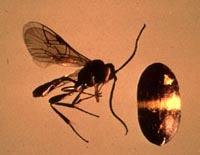
Bathylplectes cucurlionis
Parasitic wasps also help keep alfalfa weevil populations in check. Bathylplectes anurus and B. curculionis are two parasitic wasps that have been introduced into the United States. Both wasps are very small, about 1/8 inch, and deposit eggs in weevil larvae. Adult female wasps lay their eggs in weevil larvae. The parasitoid larva, following hatch, kills the weevil as it completes its cocoon. A brown cocoon with a white band is formed by the parasitoid. The parasitoid cocoon may be found in the cocoons of the alfalfa weevil, and these parasitoid cocoons appear to "jump" several centimeters when disturbed.
Early harvesting is a very effective tool for the management of the alfalfa weevil. Harvesting the crop early, when alfalfa weevil populations are high, can dramatically reduce weevil densities. This helps to remove food and shelter from larvae and also increases their exposure to harmful rays from the sun. Reports indicate that harvesting can reduce pest populations by 95-98%. The windrows of hay also create a suitable environment that allows for the development and spread of the fungus Zoophthora phytonomi.
There are several insecticides registered for the control of alfalfa weevil. In recent years insecticide use in alfalfa has decreased. Biological and cultural control practices often keep alfalfa pests below economic levels. Monitoring of alfalfa fields for insect pests and crop development will help determine the need for management strategies.
More Information
- Integrated Pest Management of Alfalfa Insects in the Upper Midwest. Leopold Center for Sustainable Agriculture. Publication IPM-58. Iowa State University. Ames, IA.
- Radcliffes IPM World Textbook: Alfalfa IPM. (http://ipmworld.umn.edu/chapters/flanders.htm).